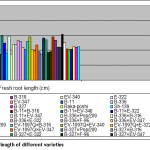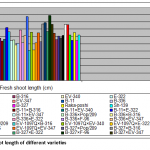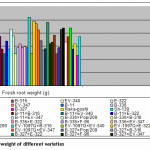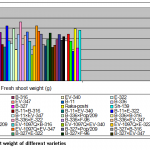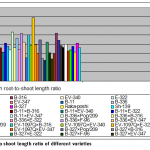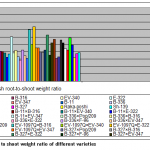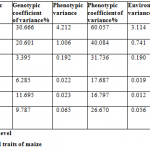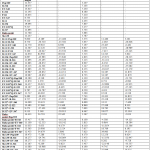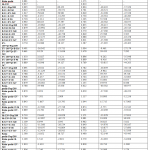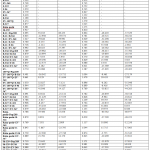Research Article
Heritability, heterosis and heterobeltiosis studies for morphological traits of maize (Zea mays L.) seedlings
Qurban Ali1*, Muhammad Ahsan1, Fawad Ali1, Muhammad Aslam1, Nazar Hussain Khan1, Mubashir Munzoor1, Hafiz Saad Bin Mustafa2, Sher Muhammad3
Adv. life sci., vol. 1, no. 1, pp. 52-63, November 2013
*Corresponding Author: Qurban Ali (Email: saim1692@gmail.com)
Author Affiliations
2-Oilseeds Research Institute, AARI, Faisalabad – Pakistan
3-CABB, University of Agriculture, Faisalabad – Pakistan
Abstract
Introduction
Methods
Results
Discussion
References
Abstract
Background: Maize is one of most important cereal crop in world after wheat and rice. It is grown in Pakistan as a major cash crop cultivation in the area of 1083 thousand hectares producing 3990 thousand tones. Maize is dual propose crop it is used as feed for livestock and food for human. It is also used as a raw material in textile, food and medicine industries. The present study was conducted to evaluate parents and F1 hybrids of maize for seedling traits including heritability, heterosis and heterobelteiosis.
Methodology: The genetic material was comprised of twelve parents and including their 36 F1 hybrids. The parents and F1 hybrids were sown in the iron treys filled with sand in three replications following completely randomized design. The data was recorded for fresh root length, fresh shoot length, fresh root-to-shoot length ratio, fresh root weight, fresh shoot weight and fresh root-to-shoot weight ratio. The data was subjected for analysis genotypic and phenotypic coefficients of variance. The genetic advance was calculated by using Falconer (1989) formula.
Results: The average batter performance was given by B-336, EV-347, EV-1097Q and B-327. The F1 hybrids, EV-1097Q × EV-347, EV-1097Q × EV-340, Raka-poshi × EV-347, B-327 × B-316 and Sh-139 × EV-347 showed higher values of heterosis and heterobeltiosis for respected studied traits of maize seedlings.
Conclusion: In this study, it is concluded that the F1 hybrids, EV-1097Q x EV-347, EV-1097Q x EV-340, Raka-poshi x EV-347, B-327 x B-316 and Sh-139 x EV-347 may be used as higher yield maize hybrids and parents EV-347, EV-1097Q, B-327 and B-316 may be used to develop higher yield maize hybrids following heterosis breeding scheme.
Keywords: Maize, Heritability, Heterosis, Heterobeltiosis, Plant breeding, Plant genetics, Morphological traits
Introduction
Maize is one of most important cereal crop in world after wheat and rice. It is grown in Pakistan as a major cash crop cultivation in the area of 1083 thousand hectares producing 3990 thousand tones. Maize is dual propose crop it is used as feed for livestock and food for human. It is also used as a raw material in textile, food and medicine industries. It contains 9.50% fiber, 72%, 3.0% sugar, starch, 4.80% oil, 10% protein and 1.70% ash [1]. The present study was conducted to evaluate parents and F1 hybrids of maize for seedling traits. In the selection of maize genotypes with higher yield, higher heritability and genetic advance help are important which in turn increase the grains production of maize.
The major objective of this current study was to asses the potential of different varities of maize crop on account of their seedling characteristics.
Methods
The present study was carried out in the glasshouse of Department of Plant Breeding and Genetics, University of Agriculture Faisalabad, Pakistan during crop season of 2012. The genetic material was comprises of twelve parents and including their 36 F1 hybrids. The parents and F1 hybrids were sown in the iron treys filled with sand in three replications following completely randomized design. The data was recorded fresh shoot length, for fresh root length, fresh root weight, fresh shoot weight, fresh root-to-shoot weight ratio and fresh root-to-shoot length ratio. The data was subjected for analysis of variance [2]. The genotypic and phenotypic coefficients of variance were calculated by Kwon and Torrie (1964) technique [3]. The genetic advance was calculated by using Falconer (1989) formula [4].
Parents and F1 hybrids
| Pop/209 | B-11×Pop/209 | EV-1097Q×Pop/209 | Raka-poshi×Pop/209 |
| B-316 | B-11×B-316 | EV-1097Q×B-316 | Raka-poshi×B-316 |
| EV-340 | B-11×EV-340 | EV-1097Q×EV-340 | Raka-poshi×EV-340 |
| E-322 | B-11×E-322 | EV-1097Q×E-322 | Raka-poshi×E-322 |
| F-96 | B-11×F-96 | EV-1097Q×F-96 | Raka-poshi×F-96 |
| EV-347 | B-11×EV-347 | EV-1097Q×EV-347 | Raka-poshi×EV-347 |
| B-11 | B-336×Pop/209 | B-327×Pop/209 | Sh-139×Pop/209 |
| B-336 | B-336×B-316 | B-327×B-316 | Sh-139×B-316 |
| EV-1097Q | B-336×EV-340 | B-327×EV-340 | Sh-139×EV-340 |
| B-327 | B-336×E-322 | B-327×E-322 | Sh-139×E-322 |
| Raka-poshi | B-336×F-96 | B-327×F-96 | Sh-139×F-96 |
| Sh-139 | B-336×EV-347 | B-327×EV-347 | Sh-139×EV-347 |
It is cleared from table 1 that higher heritability was recorded for fresh root and shoot length and fresh shoot weight while higher genetic advance was recorded for fresh root and shoot length, fresh shoot weight and fresh root-to-shoot weight ratio. Selection of higher yielding maize genotypes on the basis of higher heritability and genetic advance may be helpful to increase grain production of maize [5,6]. The higher fresh root length was recorded for B-336 (19.693cm), B-316 (16.073cm), EV-1097Q×EV-340 (14.457cm) and Raka-poshi×Pop/209 (14.413cm) as shown from table 2 and figure 1. Higher fresh shoot length was recorded for E-322 (8.180cm), B-336×EV-347 (8.733cm), B-327×E-322 (8.860cm) and B-327×B-316 (7.763cm) as shown from table 2 and figure 2. Higher fresh root-to-shoot length ratio was found for EV-1097Q×EV-340 (3.445) and Raka-poshi×Pop/209 (2.590) as shown in table 2 and figure 3. Higher fresh root and shoot weight was recorded for B-316 (0.889g, 1.060g), B-336 (0.957g, 1.166g), EV-1097Q×Pop/209 (1.040g, 0.750g) and B-327×EV-340 (0.962g, 0.388g) EV-1097Q×E-322 (0.940g, 1.050g) respectively as shown in table 3 and figure 4 and 5. Higher fresh root-to-shoot weight ratio was found for Pop/209 (1.884), EV-1097Q×EV-340 (1.479) and EV-1097Q×Pop/209 (1.387) as shown in table 3 and figure 6. Higher mean performance indicated that these parents and F1 hybrids may be used to develop higher yielding maize genotypes [6].
It is persuaded from table 2 that higher heterosis for fresh root length was recorded for B-11 x EV-347 (84.936), Raka-poshi x EV-347 (34.679), EV-1097Q x EV-347 (46.002), B-11 x EV-340 (29.922), EV-1097Q x EV-340 (26.021) and Sh-139 x EV-347 (24.244) while lower heterosis was recorded for B-11 x B-316 (-30.509), B-336 x Pop/209 (-43.983), B-336 x B-316 (-33.495) and B-336 x EV-340 (-28.672). The higher value of heterobeltiosis for fresh root length was recorded for B-11 x EV-347 (60.812), Raka-poshi x EV-347 (5.896), EV-1097Q x EV-347 (25.760), B-11 x E-322 (10.978), Raka-poshi x Pop/209 (22.562), B-327 x E-322 (13.369) and Raka-poshi x F-96 (12.524).
Higher fresh shoot length was recorded for E-322 (8.180cm), B-336×EV-347 (8.733cm), B-327×E-322 (8.860cm) and B-327×B-316 (7.763cm) as shown from table 12 and figure 2. Higher fresh root-to-shoot length ratio was found for EV-1097Q×EV-340 (3.445) and Raka-poshi×Pop/209 (2.590) as shown in Table 2 and Figure 3. Higher fresh root and shoot weight was recorded for B-316 (0.889g, 1.060g), B-336 (0.957g, 1.166g), EV-1097Q×Pop/209 (1.040g, 0.750g) and B-327×EV-340 (0.962g, 0.388g) EV-1097Q×E-322 (0.940g, 1.050g) respectively as shown in table 3 and figure 4 and 5. Higher fresh root-to-shoot weight ratio was found for Pop/209 (1.884), EV-1097Q×EV-340 (1.479) and EV-1097Q×Pop/209 (1.387) as shown in table 3 and figure 6. Higher mean performance indicated that these parents and F1 hybrids may be used to develop higher yielding maize genotypes [6]. It is persuaded from table 2 that higher heterosis for fresh root length was recorded for B-11 x EV-347 (84.936), Raka-poshi x EV-347 (34.679), EV-1097Q x EV-347 (46.002), B-11 x EV-340 (29.922), EV-1097Q x EV-340 (26.021) and Sh-139 x EV-347 (24.244) while lower heterosis was recorded for B-11 x B-316 (-30.509), B-336 x Pop/209 (-43.983), B-336 x B-316 (-33.495) and B-336 x EV-340 (-28.672). The higher value of heterobeltiosis for fresh root length was recorded for B-11 x EV-347 (60.812), Raka-poshi x
EV-347 (5.896), EV-1097Q x EV-347 (25.760), B-11 x E-322 (10.978), Raka-poshi x Pop/209 (22.562), B-327 x E-322 (13.369) and Raka-poshi x F-96 (12.524).
Discussion
Results similar with this study are also reported in different research reports [7-10]. It is persuaded from table 2 that higher heterosis and heterobeltiosis for fresh shoot length was recorded for B-327 x Pop/209 (41.430, 34.823), Raka-poshi x EV-347 (39.963, 34.134), B-327 x B-316 (22.418, 10.699) and Sh-139 x EV-347 (32.949, 26.324) respectively, while lower for EV-1097Q x EV-340 (-32.889, -41.954), B-336 x E-322 (-35.613, -37.082), B-336 x Pop/209 (-25.870, -38.215) and B-336 x B-316 (-31.410, -34.50) respectively. Similar results were found in other studies [6,7,10]. It is persuaded from table 3 that higher heterosis and heterobeltiosis for fresh root-to-shoot length ratio was recorded for EV-1097Q x EV-340 (88.737, 82.776), B-11 x EV-347 (58.694, 29.210), EV-1097Q x EV-347 (45.812, 26.267) and Sh-139 x E-322 (24.327, 5.772) respectively, while lower for B-336 x EV-347 (-34.012, -50.105), B-327 x Pop/209 (-42.396, -43.847) and B-327 x B-316 (-48.539, -50.769) respectively. Similar results were found by others in different studies [3,6,7,10]. It is persuaded from table 3 that higher heterosis and heterobeltiosis for fresh root weight was recorded for EV-1097Q x Pop/209 (69.014, 59.427), EV-1097Q x EV-340 (61.944, 49.821), B-11 x F-96 (59.384, 51.373) and EV-1097Q x E-322 (51.544, 44.149) respectively, while lower for B-336 x Pop/209 (-36.039, -48.693), B-336 x B-316 (-36.475, -38.732) and EV-1097Q x B-316 (-36.072, -44.581) respectively. These results are consistent with studies too [3,6,7,10]. It is persuaded from table 4 that higher heterosis and heterobeltiosis was recorded for for fresh shoot weight of B-11 x Pop/209 (91.612, 66.453), B-11 x EV-340 (79.839, 39.991), B-11 x EV-347 (66.025, 27.397) and Raka-poshi x Pop/209 (59.460, 15.655) respectively, while lower for Sh-139 x E-322 (-38.852, -43.825), Sh-139 x B-316 (-42.986, -46.527) and B-336 x B-316 (-39.190, -40.737) respectively. Similar results were found in previous [3,6,7,10]. It is persuaded from table 4 that higher heterosis and heterobeltiosis was recorded for fresh root-to-shoot weight ratio of B-327 x B-316 (144.467, 116.951), EV-1097Q x B-316 (110.151, 91.287), B-327 x F-96 (77.250, 48.293) and Sh-139 x F-322 (88.775, 55.920) respectively, while lower for B-336 x EV-340 (-45.254, -54.098), B-336 x Pop/209 (-32.896, -51.339) and B-336 x B-316 (-31.806, -47.098). Similar results were found in studies on maize before this one [3,6,7,10,11]. Higher values of heterosis and heterobeltiosis of F1 hybrids indicated that selection of respective parents may be helpful to develop higher yielding maize hybrids under drought conditions. It is concluded in this studythat the F1 hybrids, EV-1097Q x EV-347, EV-1097Q x EV-340, Raka-poshi x EV-347, B-327 x B-316 and Sh-139 x EV-347 may be used as higher yield maize hybrids and parents EV-347, EV-1097Q, B-327 and B-316 may be used to develop higher yield maize hybrids following heterosis breeding scheme.
References
- Tahir A, Habib N. Forecasting of maize area and production in pakistan. ESci Journal of Crop Production, (2013); 2(2): 44-48.
- Steel R, Torrie J. Principles and procedures of statistics: a Biometrical approach MCGraw-HillBook Company Toronto. REDVET, (2012); 13(6): 481.
- Jogloy C, Jaisil P, Akkasaeng C, Kesmala T, Jogloy S. Heritability and correlation for components of crop partitioning in advanced generations of peanut crosses. Asian Journal of Plant Sciences, (2011); 10(1): 60.
- Hallauer AR, Carena MJ, Miranda FilhoJd Quantitative genetics in maize breeding. 2010 of publication; Springer.
- Ali Q, Elahi M, Ahsan M, Tahir MHN, Basra SMA. Genetic evaluation of maize (Zea mays L.) genotypes at seedling stage under moisture stress. International Journal for Agro Veterinary and Medical Sciences, (2011); 5(2): 184-193.
- Ali Q, Ahsan M, Tahir MHN, Basra SMA. Genetic evaluation of maize (Zea mays L.) accessions for growth related seedling traits. International Journal for Agro Veterinary and Medical Sciences, (2012); 6(3): 164-172.
- Khan MB, Hussain N, Iqbal M. Effect of water stress on growth and yield components of maize variety YHS 202. Journal of Research (Science), (2001); 1215-18.
- Shreenivasa A, Singh R. Combining ability studies for some morpho-physiological and biochemical traits related to drought tolerance in maize. Indian Journal of Genetics, (2001); 61(1): 34-36.
- Alvi MB, Rafique M, Tariq MS, Hussain A, Mahmood T, et al. Hybrid vigour of some quantitative characters in maize (Zea mays L.). Pakistan Journal of Biological Sciences, (2003); 6(2): 139-141.
- Vafias B, Ipsilandis C. Combining ability, gene action and yielding performance in maize. Asian J Plant Sci, (2005); 4(1): 50-55.
-
Ahsan M, Farooq A, Khaliq I, Ali Q, Aslam M, et al. Inheritance of various yield contributing traits in maize (Zea mays L.) at low moisture condition. African Journal of Agricultural Research, (2013); 8(4): 413-420.


